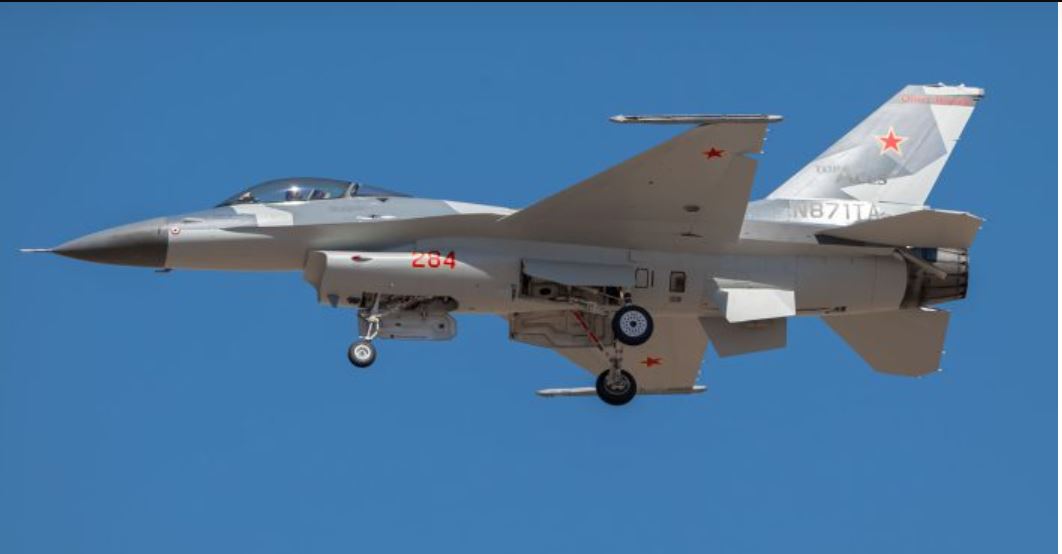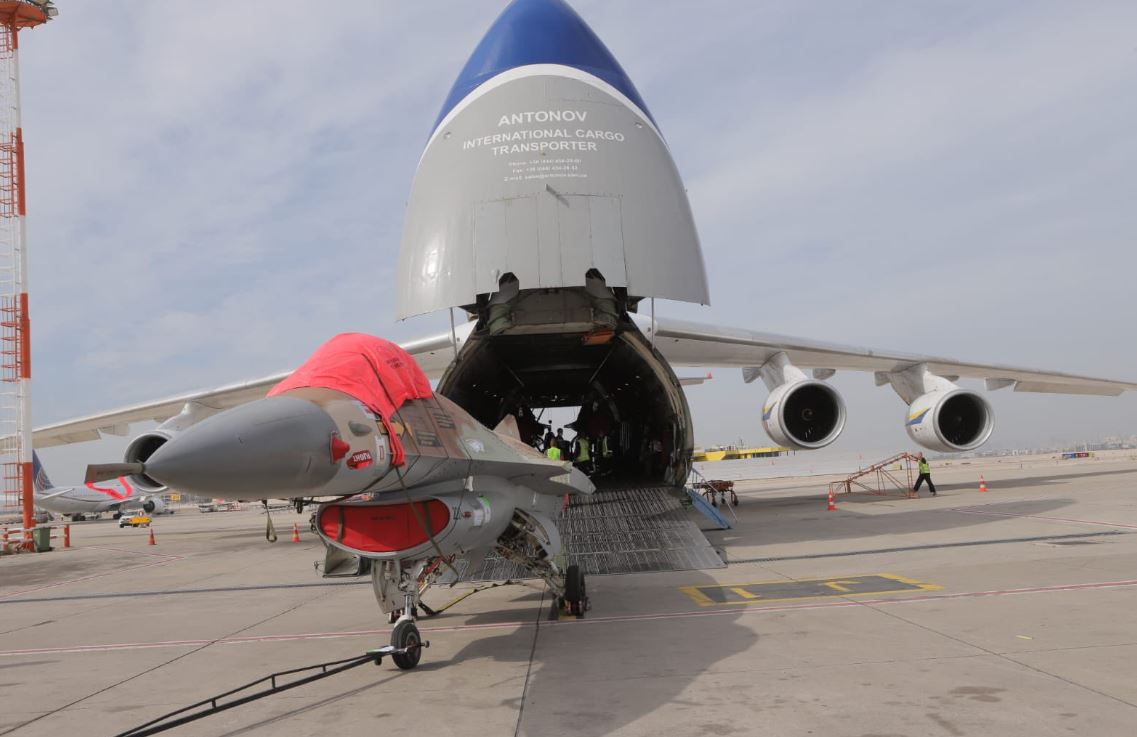A Top Aces’ F-16A fighter jet has been spotted in an eye-catching new adversary paint scheme. The fighter aircraft, formerly with the Israeli Air Force, was seen supporting a Russian Su-57 Felon-inspired paint scheme.
Dubbed the “Felon Paint Job,” the aircraft was spotted in Arizona. It flew from Mesa Gateway Airport, where Top Aces performs maintenance on its F-16s, to Luke AFB, Arizona, as ACES 51.
After reaching Luke AFB, Arizona, the fighter jet took part in a local mission under the callsign ACES 1.
Though the fighter jet, formerly known as Netz 284, was also photographed while being wheeled out of the paint barn at Mesa, its return to Luke AFB, Arizona, offered a better look.
The F-16, tail number N871TA and bort number “284” Red, features a low-visibility, splinter-style grey camouflage pattern similar to that used by Russia’s fifth-generation stealth fighter.
The two-tone scheme includes angular transitions across the airframe, mimicking the faceted radar-evading design philosophy of the T-50/Su-57, the Aviationist reported.

The “Felon Paint Job” was complete with Soviet-style red stars on its tail and wings. The tail fin also carried Cyrillic script that read “Опыт Важен” (which translates to “Experience Matters”).
Notably, despite the “Felon Paint Job,” the fighter jet still retains the kill marking it earned in September 1981, when Netz 284 shot down a Syrian MiG-23.
Last year, another F-16 fighter jet from the Top Aces fleet was spotted sporting a “Flanker Blue” color scheme, inspired by the one used by some F-16s of the U.S. Air Force’s 64th Aggressor Squadron at Nellis Air Force Base, Nevada.
It remains to be seen what other paint schemes the Top Aces F-16 fleet will support in the coming days.
F-16’s Journey: From Israeli Air Force To Top Aces
The F-16A Netz 284 was one of the fighter jets that were retired from the Israeli Air Force at the end of 2016 and delivered to the US in 2021.
The aircraft was part of the 29 F-16 Netz (Hawk) fighter jets, which retired from the Israeli Air Force in 2016 after 36 years in service, and were subsequently bought by Top Aces for adversary training.
In 2021, the Israeli Ministry of Defense acknowledged the unprecedented sale of 29 F-16 Netz (Hawk) aircraft to Top Aces.
“Following negotiations led by SIBAT, the MoD has signed an unprecedented agreement to supply 29 F-16 aircraft to TOP ACES. These will be employed as staged adversary aircraft in U.S. Air Force training,” the Israeli Ministry of Defense posted on social media site X in 2021.
The first four of these F-16s were received at Phoenix-Mesa Gateway Airport in February 2021.
The four F-16s, with their wings, tail, and tailerons removed, were loaded on a Ukrainian Antonov An-124 at Tel Aviv-Ben Gurion airport on January 27 and, after a stop in Keflavik, Iceland, they arrived a day later at Phoenix-Mesa Gateway airport.

With these F-16s, Top Aces became the first company to provide a 4th-generation aircraft for staged adversary aircraft training. Till today, these F-16s remain the world’s only privately owned F-16s.
The F-16s were subsequently upgraded to a standard that is known as F-16 AAF (Advanced Aggressor Fighter).
These upgrades included the proprietary Advanced Aggressor Mission System (AAMS), which allows the F-16s to accurately replicate near-peer adversary fighters, enhancing training realism for U.S. pilots, AESA radars, infrared search and track (IRST), helmet-mounted cueing systems, datalinks, and electronic countermeasures to replicate near-peer threats.
The Top Aces’ F-16 fleet has also been equipped with IRST pods.
The “Felon Paint Job” for the F-16 suggests that in the coming days, the US Air Force pilots want to train against the threat posed by advanced fifth-generation Russian aircraft, the Su-57 Felon.
The Su-57 Felon Threat
After struggling with slow deliveries, it seems that Russia is finally making progress with expanding Su-57 production lines.
While the Komsomolsk-on-Amur Aviation Plant is the primary production facility, new facilities have been opened to support this.
Officials have put into operation new development facilities related to the fuel system and started construction of a hangar for avionics testing at the Komsomolsk-on-Amur factory in eastern Russia, the state-owned aerospace conglomerate United Aircraft Corporation announced in August last year.
Russia only has a small number of Su-57 aircraft and they have played a limited role in the war in Ukraine, confined mainly to long-range strikes from within Russian territory.

The contract for the production of 76 planes by the end of 2027 was signed by the Defense Ministry at the Army Forum in June 2019, with Komsomolsk-on-Amur specified as the leading production site.
However, the plant was quickly deemed too small, forcing officials to spend time expanding production space, which entailed changing and adding new equipment.
The Su-57, designed to compete with NATO’s fifth-generation fighters, such as the US F-22 Raptor and F-35 Lightning II, boasts cutting-edge stealth technology, supermaneuverability, and advanced avionics. The VKS received three batches of aircraft over the last year, with the last delivery recorded in December 2024.
Furthermore, in February this year, Yuri Kondratyev, Director of the Komsomolsk-on-Amur Aircraft Production Association (KnAAPO), said that a new version of the aircraft will be delivered to the VKS in 2025.
He did not specify any particular improvements, although there is speculation that the new version might feature the more advanced AL-51F1 or product 30 engines, which could improve the fighter’s performance.
Russian aerospace engineers are also continuously improving the Su-57 avionics and armaments.
Earlier this year, UAC chief Vadim Badekha said that as production expands, the aircraft will be integrated with newer features.
“The Su-57 platform has been created for a minimum of 40-50 years. It has an open architecture and can use a broad range of technologies with minimal changes to the basic solutions. Su-57 integration with unmanned aerial vehicles will be the central element of future combat systems. In the coming years, new features will be introduced into the serial Su-57 in the framework of the modernization program,” he said.
Additionally, last week, Chief of the Main Staff and First Deputy Commander in Chief of the Russian Aerospace Forces Lieutenant General Alexander Maksimtsev said that the Su-57 fifth-generation fighter has been equipped with hypersonic weapons.
“In accordance with the state defense order, the Aerospace Forces annually receive advanced and modernized weapon systems. The pace of deliveries of fifth-generation Su-57 aircraft is increasing, along with modern aviation strike systems and hypersonic weapons,” the commander reported in an interview.
There is speculation that the hypersonic weapon referred to is an air-launched derivative of the Zircon hypersonic cruise missile. Integrating the Zircon hypersonic cruise missile with the Su-57 will make it a much more lethal platform.
The F-16’s “Felon paint job” suggests that the USAF pilots are finally gearing up to train against the Russian Air Force’s most advanced fighter jet.



